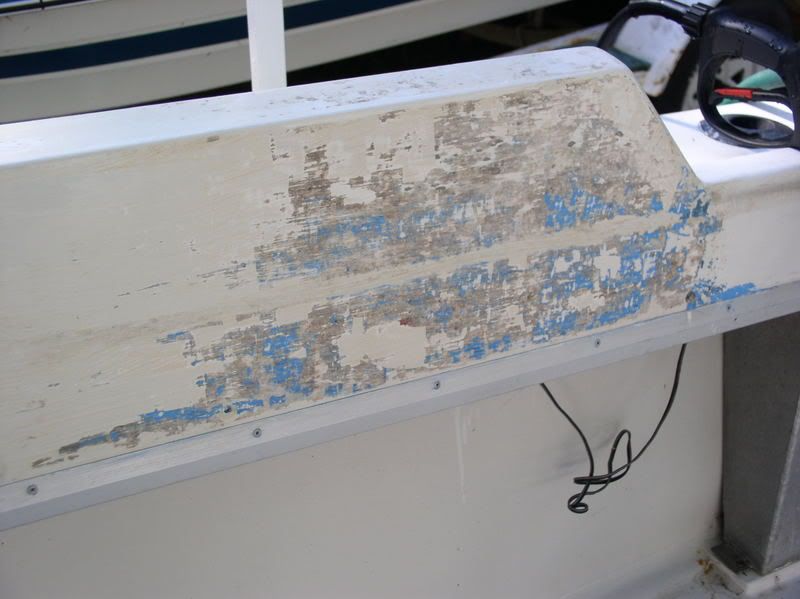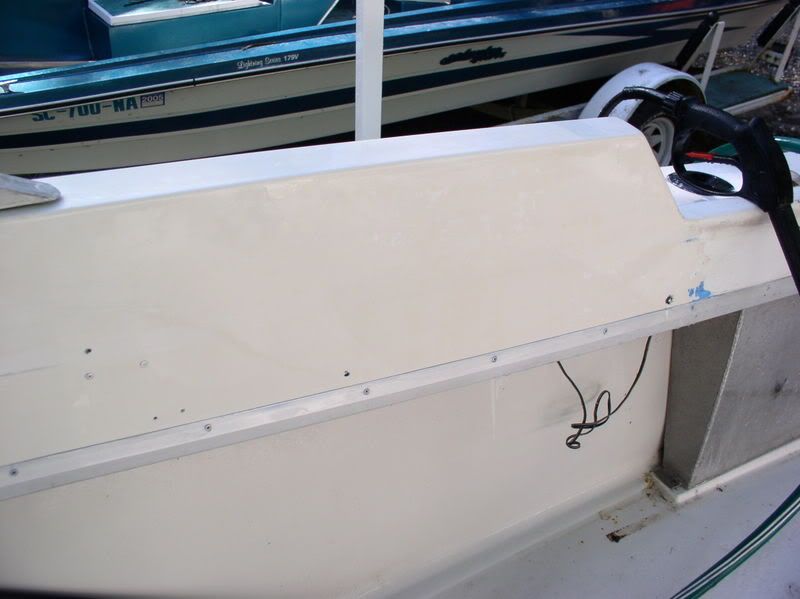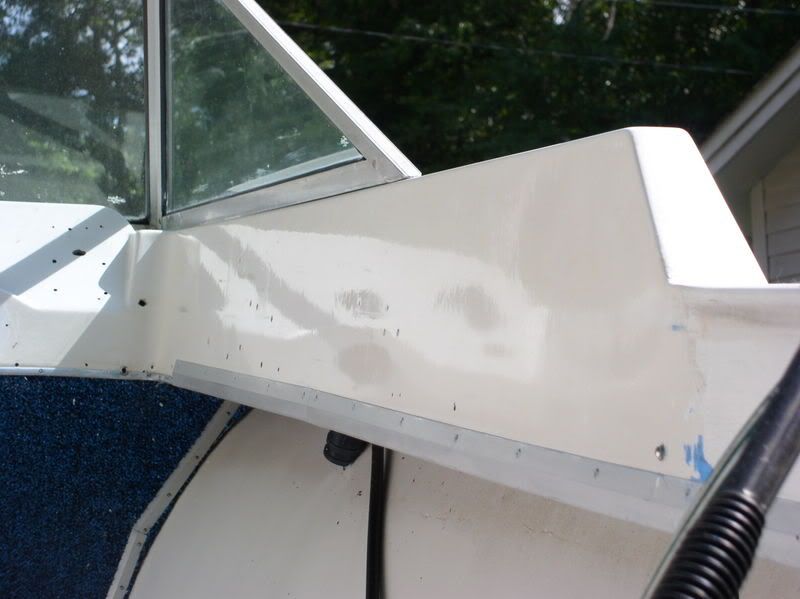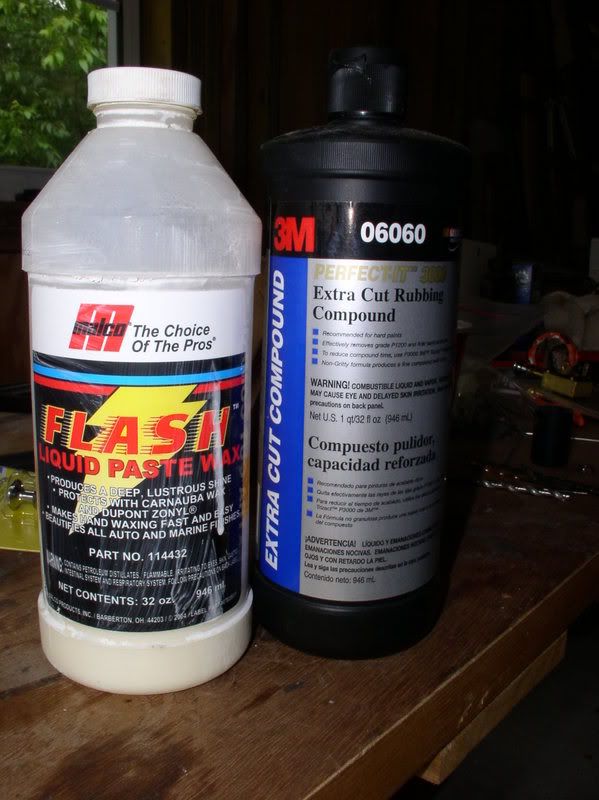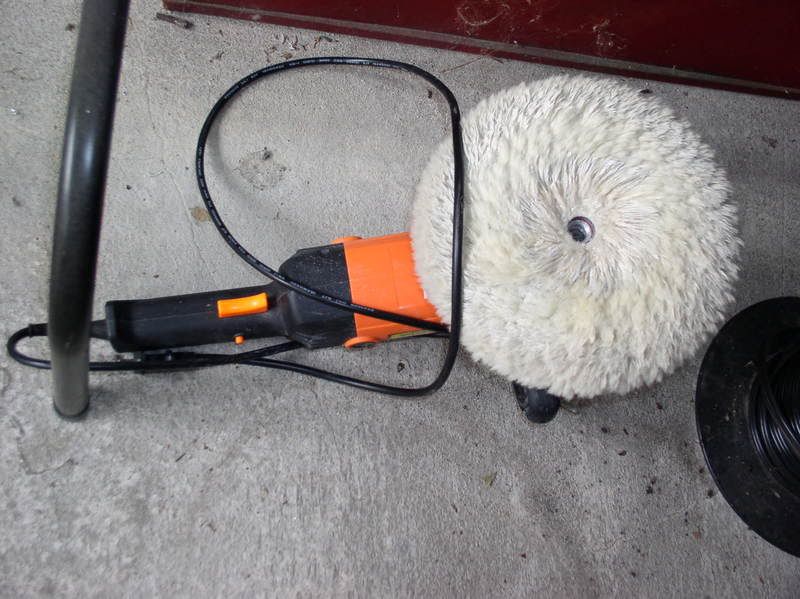Not to sound "girly", but I would really like to get the fiberglass shine back on my 88. Oxidation is fairly bad, especially topside. I don't want to cover it up with a polish, but rather compound, sand and wax. So I am looking for suggestions on the steps and materials to use. I have a new 12000RPM Porter Cable Random Orbit sander (5" 8 hole hook and loop) and also a Craftsman sander/polisher. I have researched all variations on doing this job. Some say to just sand all the way up to 2000 grit. Others say cleaning, then polishing compound or rubbing compound and then wax.

Wellcraft, V20 and Steplift remain the property of the Wellcraft Company
Install the app
How to install the app on iOS
Follow along with the video below to see how to install our site as a web app on your home screen.
Note: This feature may not be available in some browsers.
You are using an out of date browser. It may not display this or other websites correctly.
You should upgrade or use an alternative browser.
You should upgrade or use an alternative browser.
Cleanup Time
- Thread starter boatnluvr
- Start date
Stillrunning
Senior Member
I have tried about everything on the market and I get the boat nice and shiny then in about a month it starts loosing its shine. I have used this stuff the past couple of years and it does what it says it will do. The pic's are the same result as I had and its easy to do. The hardest part is scrubbing the boat to get it as clean as you can prior to applying the product. It last a good year and the next year you only have to touch up. It does take abou 6 coats to get a very good shine but on my 20' V20 I can do the hull in about 10min if that. Check out their site.
http://www.marinestore.com/vertglas-images.html?cart=32651773889586
http://www.marinestore.com/vertglas-images.html?cart=32651773889586
tsubaki
God
I'm still in the process of removeing old paint both properly and improperly installed on the upper deck. I'm having to use stripper and then sometimes watersand with sanding blocks and then buff with compound till it shines and then cover with wax to maintain some long term gloss.
Don't use any sanding stuff (grinders etc), just buy a cheap buffer (Harbor Freight etc) and get some good grade buffing compound and polish most likely from a professional auto body supply shop. Store chains usually don't carry real compound but what they got will work on very slightly oxidised coats.
Experiment on flat easy surfaces till you get the feel of it and shine desired.
Don't use any sanding stuff (grinders etc), just buy a cheap buffer (Harbor Freight etc) and get some good grade buffing compound and polish most likely from a professional auto body supply shop. Store chains usually don't carry real compound but what they got will work on very slightly oxidised coats.
Experiment on flat easy surfaces till you get the feel of it and shine desired.
tsubaki
God
The whole key to this is the fact that the paint is dry, much like blued steel that has not been oiled in a while.
If you get a good enough gloss from buffing don't stop there. Polish and keep polishing. At some point you can taper off and only do it a couple times a year.
The product and application that Still posted is the most correct way to go about it.
If you get a good enough gloss from buffing don't stop there. Polish and keep polishing. At some point you can taper off and only do it a couple times a year.
The product and application that Still posted is the most correct way to go about it.
Skools Out
God
there's a reason boats have been painted usually they have repairs so you may strip part of it but you will find the repairs and then have to repaint to hull anyway. Also the more you buff the less Gelcoat you have and that's thin to start with so you only get a couple buffings before you will have major problems with osmedic blisters all over the boat cause the thin gelcoat will take in water and the glass under that will create an acid and eat holes in your boat. go with this
http://www.poliglowproducts.com/index2.phtml
http://www.poliglowproducts.com/index2.phtml
tsubaki
God
Yes that is the coarsest I could find. And I suggest useing caution if you have never used a buffer to any great extent. I painted automobiles for 5 years out of high school.
In my case, the boat hasen't been washed in at least 5 years, much less waxed.
You may not need as coarse a compound as what I got.
In my case, the boat hasen't been washed in at least 5 years, much less waxed.
You may not need as coarse a compound as what I got.
Skools Out
God
lol yeah that would have been my responce too. that Poliglow works good used it on the motorhome and i'm going to test it on a few of my boats and may even try it on my Vette lol
When you use compound with a buffer, do you have to apply with a foam pad on the buffer, wait for it to glaze dry and then remove and polish with a bonnet? Or can you apply and buff all at once with a bonnetor foam pad? As you can see, I did not paint cars for 5 years out of high school. I am agreeing with the suggestions to use polyglow or Vertglas, but I still have to get rid of the layer of chaulky oxidation first.
Skools Out
God
hey Boatn that Poli Glow Kit with the prep will remove the chalky stuff too, you just clean with the prep and their scruber and the apply the poli glow polish
T
twistedparot
Guest
if ur gonna buff, be carefull. buffing compound is liquid sandpaper. so wrrk in stages like sanding. working ur way up to a fine grit polish. use a spur or screw driver to keep ur pad clean. what you are worried when buffing is burning the finish. this comes from going to slow, dirty bonnet, or rolling onto the edge. it is exactly what it sounds like. buffer will build up heat and burn the finish. be extra careful on edges. make sure to position the buffer so that as it turns it 'rolls off' the edge.
and wear an apron and move ur wifes car far away. when you think you got it far enough, move it a little farther.
and wear an apron and move ur wifes car far away. when you think you got it far enough, move it a little farther.
tsubaki
God
twisted's right and Skools I believe has the best approach for nondamaged gelcoat for the long run.
When buffing we used to get in a metal gallon bucket of compound and knock a hole in it about 2" round so as to be able to put a paint paddle in it. With the paint paddle we would smear or slap the car, dotting the compound around the area to be buffed.
The newer stuff you can scoot out the bottle on the area but the best way is to apply an even coat with a rag across the location to be buffed.
Buff immediately and when thru wipe off with a clean wrag and then start with the polish.
You must polish after buffing, the area is basically virgin and will hold stains easily.
Again I like Skools approach if just getting the shine back.
When buffing we used to get in a metal gallon bucket of compound and knock a hole in it about 2" round so as to be able to put a paint paddle in it. With the paint paddle we would smear or slap the car, dotting the compound around the area to be buffed.
The newer stuff you can scoot out the bottle on the area but the best way is to apply an even coat with a rag across the location to be buffed.
Buff immediately and when thru wipe off with a clean wrag and then start with the polish.
You must polish after buffing, the area is basically virgin and will hold stains easily.
Again I like Skools approach if just getting the shine back.
macojoe said:I just use it till the flys are all over it, as the case today!! But I am going fishing again tomorrow so I know care!
Tomorrow I will just bleach the crap out of it and go again, I have had my boat 8 or 9 years, never seen a drop of wax!!;D
I agree MJ, but having just spent about $13000 repairing this boat, I would like it to at least look like it never sunk. Plus, I have to take pics for the insurance and we all know shiny is better.
Thanks to all. I will be taking the easy way out with one of the polishes and I'll save my sander and polisher for the heavy fiberglass work remaining. I'll take some before/after pics this weekend.
Stillrunning
Senior Member
Sorry for not responding quicker. I used the oxidation remover but I think using soft scrub and giving it good scrub down would do just as good. The main thing is to get the boat very clean as you will seal in anything left on the glass. The stuff works and I would buy the big bottle the 10inch, 4inch brush. Then go to the hard wear store and get one of those long plastic containers for holding drywall compound. You scrub down the boat then wash it down real good getting any left over gritt from the soft scrub off. Pore the stuff in the container and start with the hule using the 10" brush and use the 4" for tight spots. On their site they give good tips so read them first. The main thing is it will take around 6 coats but they go real quick with that wide brush. Do not put it on thick and watch for any runs as you can see them.boatnluvr said:Tsubaki, Is that 3M compound OK for gelcoat? Looks heavy duty.
Still, Did you use the Oxidation remover from Vertglas?
I am thinking....get a shine on it for now and then perhaps a more detailed job in the fall.
Thanks Guys!
